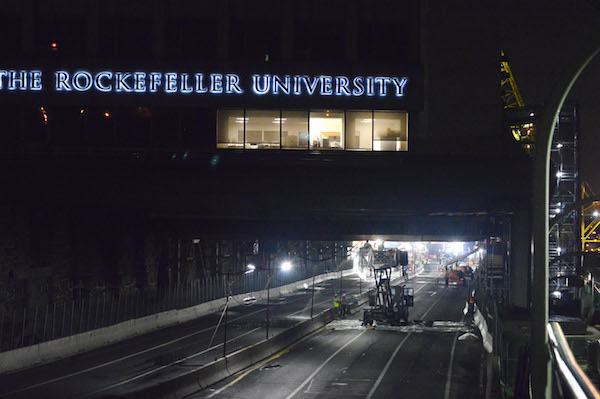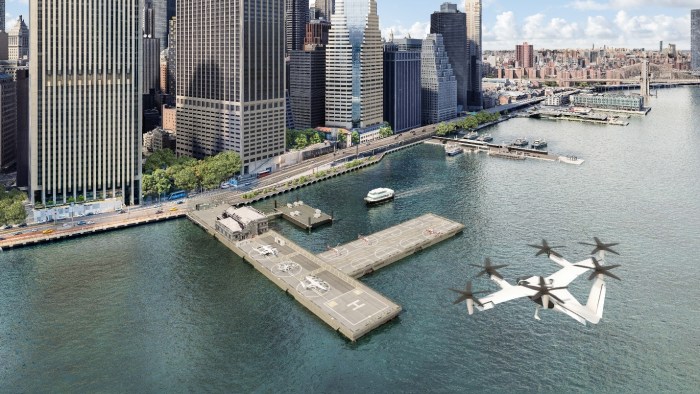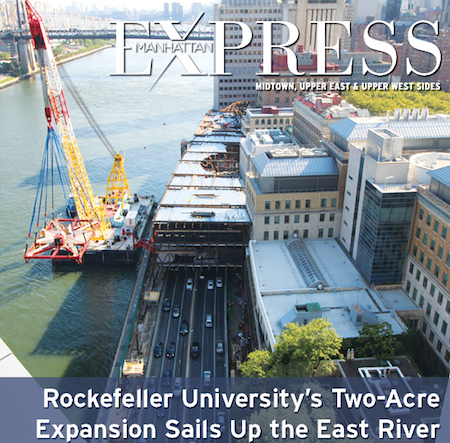
BY JACKSON CHEN | In the dead of night over the weekends of July 29 to August 1 and August 5 to 8, the hum of traffic was noticeably absent from the FDR Drive from East 61st to 96th Streets. Where there normally would be late night taxis zooming by, the East Side highway was completely devoid of traveling cars and instead replaced with construction crews and their noisy equipment and occasional faint yells.
Between roughly 1 a.m. and 5 a.m. on Monday morning, August 1, the 12th of 19 enormous structural blocks that were prefabricated in New Jersey was hoist up from a barge by a towering barge crane floating on the East River. Facing the challenges of the river’s sway and of lifting an approximately 1.5 million pound structure, the 230-foot crane, with its loud sputtering motor, cautiously inched its cargo — which will form the structural base for an expansion to Rockefeller University — over the FDR Drive and then connected to other modules put in place on previous overnight shifts.
As residents of the Upper East Side snoozed away, the nocturnal contractors then began to weld and bolt the freshly placed module to support columns that rose from the sides of the highway. As the work week’s first sun began to peek out, traffic was set to resume on the FDR and the workers began prepping for the next leg of the Stavros Niarchos Foundation-David Rockefeller River Campus expansion.
The $500 million expansion project, which started in fall 2015, was designed by Rafael Viñoly Architects and will add two acres to Rockefeller University’s existing 14-acre campus centered on 1230 York Avenue at East 66th Street. According to the plans, the extension expands the university’s reach four blocks north and will incorporate state-of-the-art laboratories, a dining commons, an academic center, a conference center, gardens, and a green landscaped roof.
As part of the project, the university is also responsible for repairing the nearby seawall along the East River and beautifying the East River Esplanade that will be shadowed by the expansion.
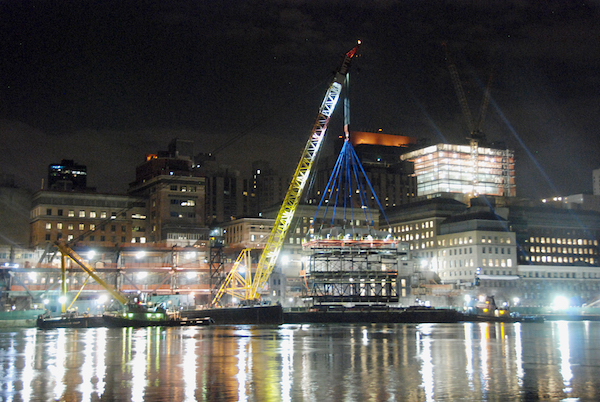
But the majority of the expansion involves the 19 modules, or connective skeletal structures, that form the base of the project. The three that were installed over the July 29 to August 1 weekend were completed between 1 a.m. and 5 a.m., except for the closure stretching to 7 a.m. on Sunday morning, July 31,with work the following week during roughly the same hours.
“Constructing the steel superstructure off-site and bringing it in via barge was the most creative and efficient way to do a building this size over a busy urban highway,” Timothy O’Connor, executive vice president at the university, said, adding that Rockefeller has owned the air rights over that portion of the FDR since the 1970s.
The creatively unique venture of building over a highway with jigsaw pieces being sailed in has attracted the attention of some residents across the river. Frank Farance, a 36-year Roosevelt Island resident, said he’s been observing and snapping photos of the construction work ever since he was aware of it two months ago.
“Just architecturally, it’s interesting,” Farance, a member of the Roosevelt Island Residents Association, said. “I saw how many spots they had to go and I said I’m just going to have to dedicate myself all night to looking at this.”
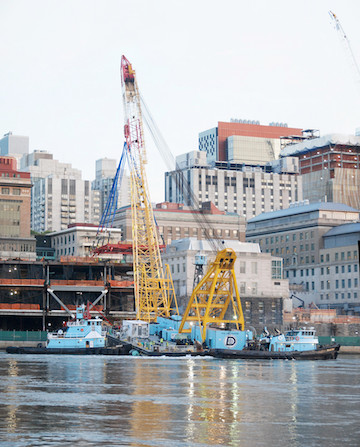
While the construction doesn’t bother him when he eventually does get to sleep, Farance still wondered if there were better uses for that space, like his suggestion for affordable housing.
“I hope something useful comes out of the space they’re taking up,” Farance said. “Because it seems to me like there’s a lot of big institutions that just grab space, and I’m not seeing what that societal benefit is other than a real estate transaction.”
While the Niarchos-Rockefeller expansion’s primary and obvious goal is to further the university’s mission with modern labs and research facilities in the expansion’s centerpiece Marie-Josée and Henry R. Kravis Research Building, Rockefeller is not ignoring the public.
Along with working to redesign the portion of the Esplanade underneath its expansion, the university has also established a $1 million fund to maintain the landscaping of the esplanade, as well as donating $150,000 to the Friends of the East River Esplanade, an organization dedicated to its restoration and reinvention from East 60th to 120th Streets.
For the most part, community members seem appreciative of the university’s diligent and welcoming approach to reaching out for residential input, according to the East Sixties Neighborhood Association.
“We think it’s very well thought out, it has minimal impact on the community except for those who use the FDR Drive in the wee hours of the morning,” Barry Schneider, co-president of the ESNA, said, adding he hasn’t heard many complaints about the closures.
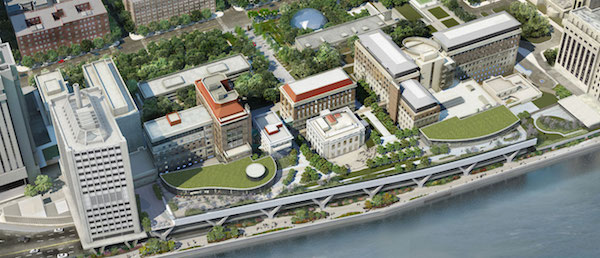
Schneider is also a member of Community Board 8, which has reviewed and approved of the project. While he acknowledges there were concerns from the community with a university expanding so widely, Schneider said, “we’re not living in a quiet cul-de-sac in Chappaqua. You have institutions, parks, bridges, schools, and it’s a huge mélange of various kinds of buildings.”
The CB8 member, and his wife Judy, who is on the board’s Parks and Recreation Committee and co-president of ESNA, both agreed that Rockefeller University was very cautious about all aspects of its project, from the affected greenery of the esplanade to the minimal impact on the FDR Drive.
“A lot of people do outreach but [Rockefeller University] did an exceeding amount of outreach,” Judy said. “They really worked with the community, and I thought they did a really well done job.”
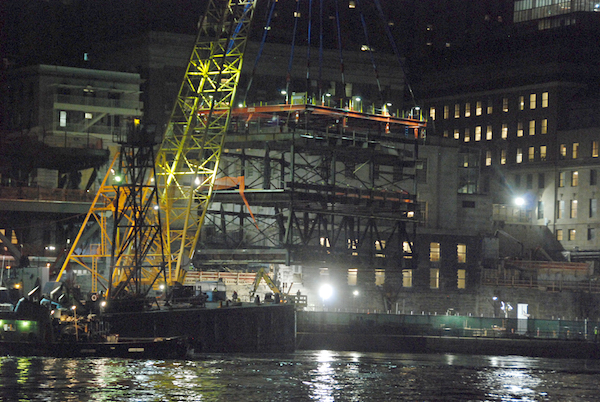
According to George Candler, Rockefeller University’s associate vice president of planning and construction, the project is on time, on budget, and produces a biannual newsletter with progress details for Upper East Siders.
“Rockefeller has been committed to making improvements that benefit the community as part of this project,” Candler said, noting that the esplanade’s redesign will include new landscaping, seating, lighting, a bike lane, and a noise barrier for the FDR Drive. “The collaborative process has helped to ensure the public enhancements meet the needs of the community.”
As the expansion project continues, the university is working alongside the city Department of Transportation to close down the FDR Drive during several dates throughout August. But in trying to be as minimally intrusive as possible, the construction will continue taking place during late-night hours. Neighborhood residents, meanwhile, will quite literally continue waking up to new portions of Rockefeller University in their midst. Though the overnight, over-the-FDR portion of the expansion should be complete before Labor Day, the overall project construction will continue until 2019.
